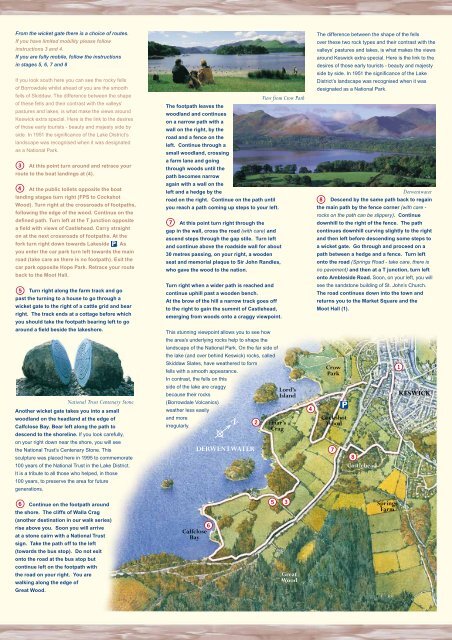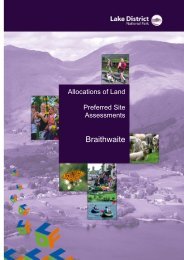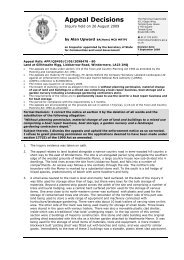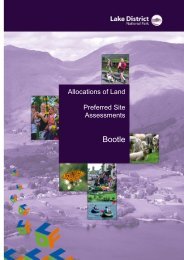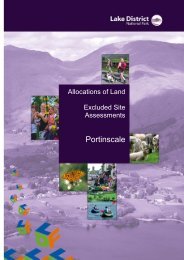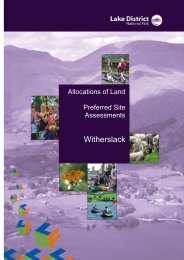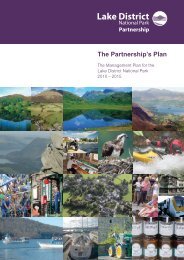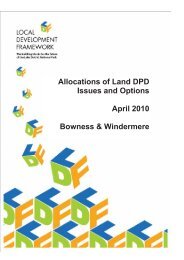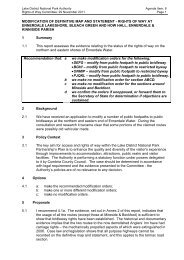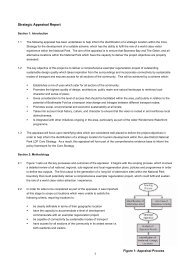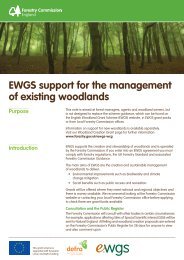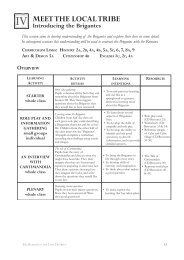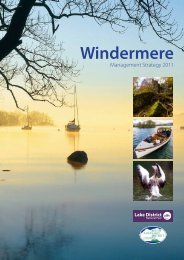Friars Crag and Castlehead Walk (PDF) - Lake District National Park
Friars Crag and Castlehead Walk (PDF) - Lake District National Park
Friars Crag and Castlehead Walk (PDF) - Lake District National Park
You also want an ePaper? Increase the reach of your titles
YUMPU automatically turns print PDFs into web optimized ePapers that Google loves.
From the wicket gate there is a choice of routes.<br />
If you have limited mobility please follow<br />
instructions 3 <strong>and</strong> 4.<br />
If you are fully mobile, follow the instructions<br />
in stages 5, 6, 7 <strong>and</strong> 8<br />
If you look south here you can see the rocky fells<br />
of Borrowdale whilst ahead of you are the smooth<br />
fells of Skiddaw. The difference between the shape<br />
of these fells <strong>and</strong> their contrast with the valleys’<br />
pastures <strong>and</strong> lakes, is what make the views around<br />
Keswick extra special. Here is the link to the desires<br />
of those early tourists - beauty <strong>and</strong> majesty side by<br />
side. In 1951 the significance of the <strong>Lake</strong> <strong>District</strong>’s<br />
l<strong>and</strong>scape was recognised when it was designated<br />
as a <strong>National</strong> <strong>Park</strong>.<br />
3<br />
At this point turn around <strong>and</strong> retrace your<br />
route to the boat l<strong>and</strong>ings at (4).<br />
4<br />
At the public toilets opposite the boat<br />
l<strong>and</strong>ing stages turn right (FPS to Cockshot<br />
Wood). Turn right at the crossroads of footpaths,<br />
following the edge of the wood. Continue on the<br />
defined path. Turn left at the T junction opposite<br />
a field with views of <strong>Castlehead</strong>. Carry straight<br />
on at the next crossroads of footpaths. At the<br />
fork turn right down towards <strong>Lake</strong>side . As<br />
you enter the car park turn left towards the main<br />
road (take care as there is no footpath). Exit the<br />
car park opposite Hope <strong>Park</strong>. Retrace your route<br />
back to the Moot Hall.<br />
5<br />
Turn right along the farm track <strong>and</strong> go<br />
past the turning to a house to go through a<br />
wicket gate to the right of a cattle grid <strong>and</strong> bear<br />
right. The track ends at a cottage before which<br />
you should take the footpath bearing left to go<br />
around a field beside the lakeshore.<br />
6<br />
<strong>National</strong> Trust Centenary Stone<br />
Another wicket gate takes you into a small<br />
woodl<strong>and</strong> on the headl<strong>and</strong> at the edge of<br />
Calfclose Bay. Bear left along the path to<br />
descend to the shoreline. If you look carefully,<br />
on your right down near the shore, you will see<br />
the <strong>National</strong> Trust’s Centenary Stone. This<br />
sculpture was placed here in 1995 to commemorate<br />
100 years of the <strong>National</strong> Trust in the <strong>Lake</strong> <strong>District</strong>.<br />
It is a tribute to all those who helped, in those<br />
100 years, to preserve the area for future<br />
generations.<br />
Continue on the footpath around<br />
the shore. The cliffs of Walla <strong>Crag</strong><br />
(another destination in our walk series)<br />
rise above you. Soon you will arrive<br />
at a stone cairn with a <strong>National</strong> Trust<br />
sign. Take the path off to the left<br />
(towards the bus stop). Do not exit<br />
onto the road at the bus stop but<br />
continue left on the footpath with<br />
the road on your right. You are<br />
walking along the edge of<br />
Great Wood.<br />
The footpath leaves the<br />
woodl<strong>and</strong> <strong>and</strong> continues<br />
on a narrow path with a<br />
wall on the right, by the<br />
road <strong>and</strong> a fence on the<br />
left. Continue through a<br />
small woodl<strong>and</strong>, crossing<br />
a farm lane <strong>and</strong> going<br />
through woods until the<br />
path becomes narrow<br />
again with a wall on the<br />
left <strong>and</strong> a hedge by the<br />
road on the right. Continue on the path until<br />
you reach a path coming up steps to your left.<br />
7<br />
At this point turn right through the<br />
gap in the wall, cross the road (with care) <strong>and</strong><br />
ascend steps through the gap stile. Turn left<br />
<strong>and</strong> continue above the roadside wall for about<br />
30 metres passing, on your right, a wooden<br />
seat <strong>and</strong> memorial plaque to Sir John R<strong>and</strong>les,<br />
who gave the wood to the nation.<br />
Turn right when a wider path is reached <strong>and</strong><br />
continue uphill past a wooden bench.<br />
At the brow of the hill a narrow track goes off<br />
to the right to gain the summit of <strong>Castlehead</strong>,<br />
emerging from woods onto a craggy viewpoint.<br />
This stunning viewpoint allows you to see how<br />
the area’s underlying rocks help to shape the<br />
l<strong>and</strong>scape of the <strong>National</strong> <strong>Park</strong>. On the far side of<br />
the lake (<strong>and</strong> over behind Keswick) rocks, called<br />
Skiddaw Slates, have weathered to form<br />
fells with a smooth appearance.<br />
In contrast, the fells on this<br />
side of the lake are craggy<br />
because their rocks<br />
(Borrowdale Volcanics)<br />
weather less easily<br />
<strong>and</strong> more<br />
irregularly.<br />
2<br />
Calfclose<br />
Bay<br />
DERWENTWATER<br />
6<br />
N<br />
View from Crow <strong>Park</strong><br />
Friar’s<br />
<strong>Crag</strong><br />
5<br />
Lord’s<br />
Isl<strong>and</strong><br />
3<br />
Great<br />
Wood<br />
4<br />
The difference between the shape of the fells<br />
over these two rock types <strong>and</strong> their contrast with the<br />
valleys’ pastures <strong>and</strong> lakes, is what makes the views<br />
around Keswick extra special. Here is the link to the<br />
desires of those early tourists - beauty <strong>and</strong> majesty<br />
side by side. In 1951 the significance of the <strong>Lake</strong><br />
<strong>District</strong>’s l<strong>and</strong>scape was recognised when it was<br />
designated as a <strong>National</strong> <strong>Park</strong>.<br />
8<br />
Crow<br />
<strong>Park</strong><br />
Cockshot<br />
Wood<br />
7<br />
8<br />
<strong>Castlehead</strong><br />
Springs<br />
Farm<br />
1<br />
Derwentwater<br />
Descend by the same path back to regain<br />
the main path by the fence corner (with care -<br />
rocks on the path can be slippery). Continue<br />
downhill to the right of the fence. The path<br />
continues downhill curving slightly to the right<br />
<strong>and</strong> then left before descending some steps to<br />
a wicket gate. Go through <strong>and</strong> proceed on a<br />
path between a hedge <strong>and</strong> a fence. Turn left<br />
onto the road (Springs Road - take care, there is<br />
no pavement) <strong>and</strong> then at a T junction, turn left<br />
onto Ambleside Road. Soon, on your left, you will<br />
see the s<strong>and</strong>stone building of St. John’s Church.<br />
The road continues down into the town <strong>and</strong><br />
returns you to the Market Square <strong>and</strong> the<br />
Moot Hall (1).<br />
KESWICK
The Countryside Code<br />
The l<strong>and</strong> in the <strong>Lake</strong> <strong>District</strong> <strong>National</strong> <strong>Park</strong><br />
is nearly all privately owned <strong>and</strong> much of it<br />
is farmed. Because of this it is especially important<br />
that you use the Countryside Code to guide your<br />
activities in the <strong>National</strong> <strong>Park</strong>:<br />
Respect, Protect, Enjoy<br />
• Be safe - plan ahead <strong>and</strong> follow any signs<br />
• Leave gates <strong>and</strong> property as you find them<br />
• Keep dogs under close control<br />
• Protect plants <strong>and</strong> animals,<br />
<strong>and</strong> take your litter home<br />
• Consider other people<br />
The fields <strong>and</strong> fells of the <strong>Lake</strong> <strong>District</strong> are<br />
pasture for sheep. Dogs do not have to attack<br />
sheep to cause them harm, particularly from late<br />
autumn through to early summer when ewes are<br />
either pregnant or with lambs.<br />
Please keep your dog on a lead.<br />
Safe <strong>and</strong> Sound<br />
wicket gate.<br />
path emerges from the woodl<strong>and</strong> at another<br />
After crossing another small bridge the<br />
(your final objective) is in view to your left.<br />
the edge of the woodl<strong>and</strong> where <strong>Castlehead</strong><br />
into woodl<strong>and</strong>. Continue on the path round<br />
small bridge <strong>and</strong> then through a wicket gate<br />
opens out to your left. The path goes over a<br />
your right. A view of the Skiddaw mountain range<br />
through the gate <strong>and</strong> continue with the lake on<br />
right <strong>and</strong> follow the path to a wicket gate. Go<br />
<strong>and</strong> then walk back to a fork in the path. Turn<br />
the Ruskin Memorial amongst the trees to your right)<br />
<strong>Walk</strong> back from the main viewpoint (noting<br />
the world for me’. What does the view mean to you?<br />
experience that he described it as ‘the creation of<br />
the view at the age of five <strong>and</strong> it was such a pivotal<br />
place almost too beautiful to live in! He first saw<br />
of the best in Europe <strong>and</strong> considered Keswick a<br />
writer <strong>and</strong> social reformer. He declared it to be one<br />
was made famous by John Ruskin, painter, art critic,<br />
of Borrowdale <strong>and</strong> the high fells of central lakel<strong>and</strong>,<br />
view from here, across Derwentwater to the ‘Jaws’<br />
which soon leads to Friar’s <strong>Crag</strong> viewpoint. The<br />
Where the path forks, take the right h<strong>and</strong> fork<br />
quarter of the l<strong>and</strong> in the <strong>Lake</strong> <strong>District</strong> <strong>National</strong> <strong>Park</strong>.<br />
the <strong>National</strong> Trust owns <strong>and</strong> protects almost one<br />
Rawnsley set up the <strong>National</strong> Trust in 1895. Today<br />
debate. Along with Robert Hunter <strong>and</strong> Octavia Hill,<br />
Honister forced the issue into Government <strong>and</strong> public<br />
fight against a quarry railway from Braithwaite to<br />
formation of the <strong>Lake</strong> <strong>District</strong> Defence Society whose<br />
for its industrial potential. He was instrumental in the<br />
The weather in the <strong>Lake</strong> <strong>District</strong> can change very<br />
quickly <strong>and</strong> you should always dress appropriately<br />
for your activity:<br />
• if you are walking, wear strong boots, take a rain<br />
jacket, some food <strong>and</strong> drink, a map <strong>and</strong> a compass<br />
• call the <strong>National</strong> <strong>Park</strong> Authority’s Weatherline<br />
Service 0844 846 2444 to check the forecast<br />
before you leave<br />
• in case of an accident away from the road,<br />
call 999 <strong>and</strong> ask for Mountain Rescue<br />
Traveline: 0871 200 2233<br />
2<br />
benefits as well as<br />
valuable for its spiritual <strong>and</strong> aesthetic<br />
of his time; he was convinced that l<strong>and</strong> was<br />
(1851-1920). Canon Rawnsley was a man ahead<br />
pass a memorial to Canon Hardwicke Rawnsley<br />
Trust site to Friar’s <strong>Crag</strong>. On your left you will<br />
becomes a gravel footpath entering the <strong>National</strong><br />
down on your right. Shortly, the metalled road<br />
Continue along the road past the boat l<strong>and</strong>ings<br />
Return to the pavement outside Crow <strong>Park</strong>.<br />
K E S W I C K W A L K S<br />
The <strong>Lake</strong> <strong>District</strong> <strong>National</strong> <strong>Park</strong><br />
With its world renowned l<strong>and</strong>scape,<br />
the <strong>National</strong> <strong>Park</strong> is for everyone to enjoy,<br />
now <strong>and</strong> in the future.<br />
It needs a prosperous economy, world class<br />
visitor experiences <strong>and</strong> vibrant communities,<br />
which sustain the spectacular l<strong>and</strong>scape.<br />
Everyone involved in running Engl<strong>and</strong>’s largest<br />
<strong>and</strong> much loved <strong>National</strong> <strong>Park</strong> is committed to:<br />
• respecting the past<br />
• caring for the present<br />
• planning for the future<br />
<strong>Lake</strong> <strong>District</strong> <strong>National</strong> <strong>Park</strong> Authority<br />
Murley Moss<br />
Oxenholme Road<br />
Kendal<br />
Cumbria<br />
LA9 7RL<br />
Phone: 01539 724555<br />
Fax: 01539 740822<br />
Minicom: 01539 792690<br />
Email: hq@lakedistrict.gov.uk<br />
Website: www.lakedistrict.gov.uk<br />
Artwork © Bob Henfrey.<br />
Photographs © Val Corbett, Keswick Tourism Association.<br />
Publication Number 02/10/ND/1K<br />
Alternative formats<br />
can be sent to you.<br />
Call 01539 724555<br />
This leaflet is printed on recycled paper<br />
K E S W I C K W A L K S<br />
live here.<br />
to visit <strong>and</strong> later, many of the <strong>Lake</strong> Poets came to<br />
account of his visit to Keswick inspired many others<br />
Glass) to enhance the mood of the view. The 1769<br />
views, often used special coloured glass (a Claude<br />
Gray, who came in search of picturesque l<strong>and</strong>scape<br />
them, made Keswick an ideal place to visit. Thomas<br />
horror <strong>and</strong> immensity’ of the l<strong>and</strong>scape which, to<br />
John Brown <strong>and</strong> Thomas Gray, admired the ‘beauty,<br />
From places like this, 18th century visitors, such as<br />
footsteps of some of the earliest visitors to Keswick.<br />
detour down to the lake at Crow <strong>Park</strong> you follow in the<br />
Crow <strong>Park</strong> is now on your right. If you take a brief<br />
your left.<br />
<strong>and</strong> Theatre on<br />
Boats at Derwentwater<br />
wishing well <strong>and</strong> continue with the <strong>Lake</strong>side<br />
have Hope <strong>Park</strong> to your right. Bear right at the<br />
tinuing towards the <strong>Lake</strong>. You now<br />
Subway to <strong>Lake</strong>). After the subway, turn left con-<br />
of the road take the footpath to the left (FPS<br />
road to the right (still <strong>Lake</strong> Road). At the bottom<br />
Continue for 100 metres, then take the paved<br />
Square by the right h<strong>and</strong> exit (<strong>Lake</strong> Road).<br />
entrance of the Moot Hall, leave the Market<br />
St<strong>and</strong>ing with your back to the main<br />
Please note that ‘FPS’ means footpath sign<br />
Distance: About 5 km<br />
Time: 2-3 hours<br />
Grade: Easy; Moderate if you<br />
include <strong>Castlehead</strong><br />
FRIAR’S CRAG<br />
<strong>and</strong> CASTLEHEAD -<br />
TOURISM THAT LED<br />
TO CONSERVATION<br />
K E S W I C K W A L K S<br />
Friar’s <strong>Crag</strong> <strong>and</strong><br />
<strong>Castlehead</strong><br />
A short but revealing walk to places that<br />
inspired early visitors <strong>and</strong> the <strong>Lake</strong> Poets,<br />
whose work came to shape our ideas about<br />
l<strong>and</strong>scape <strong>and</strong> its value. Less mobile people can,<br />
if they wish, begin from <strong>Lake</strong>side car park<br />
<strong>and</strong> complete a circular route which avoids<br />
the hill up to <strong>Castlehead</strong>.<br />
K E S W I C K W A L K S<br />
1


